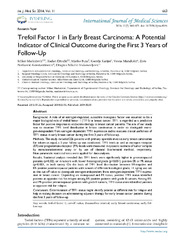Приказ основних података о документу
Trefoil Factor 1 in Early Breast Carcinoma: A Potential Indicator of Clinical Outcome during the First 3 Years of Follow-Up
| dc.creator | Markićević, Milan | |
| dc.creator | Džodić, Radan R. | |
| dc.creator | Buta, Marko | |
| dc.creator | Kanjer, Ksenija | |
| dc.creator | Mandušić, Vesna | |
| dc.creator | Nešković-Konstantinović, Zora | |
| dc.creator | Nikolić-Vukosavljević, Dragica | |
| dc.date.accessioned | 2018-03-01T15:29:57Z | |
| dc.date.available | 2018-03-01T15:29:57Z | |
| dc.date.issued | 2014 | |
| dc.identifier.issn | 1449-1907 | |
| dc.identifier.uri | https://vinar.vin.bg.ac.rs/handle/123456789/203 | |
| dc.description.abstract | Background. A role of an estrogen-regulated, autocrine motogenic factor was assumed to be a major biological role of trefoil factor 1 (TFF1) in breast cancer. TFF1 is regarded as a predictive factor for positive response to endocrine therapy in breast cancer patients. The aim of our study was to examine TFF1 level distribution in breast carcinomas in order to distinguish estrogen-independent from estrogen-dependent TFF1 expression and to evaluate clinical usefulness of TFF1 status in early breast cancer during the first 3 years of follow-up. Methods. The study included 226 patients with primary operable invasive early breast carcinomas for whom an equal, a 3-year follow-up was conducted. TFF1 levels as well as estrogen receptor (ER) and progesterone receptor (PR) levels were measured in cytosolic extracts of tumor samples by immunoradiometric assay or by use of classical biochemical method, respectively. Non-parametric statistical tests were applied for data analyses. Results. Statistical analysis revealed that TFF1 levels were significantly higher in premenopausal patients (p=0.02), or in tumors with: lower histological grade (p LT 0.001), positive ER or PR status (p LT 0.001, in both cases). On the basis of TFF1 level distribution between ER-negative and ER-positive postmenopausal patients with tumors of different histological grade, 14 ng/mg was set as the cut-off value to distinguish estrogen-independent from estrogen-dependent TFF1 expression in breast cancer. Depending on menopausal and PR status, positive TFF1 status identified patients at opposite risk for relapse among ER-positive patients with grade II tumors. Among ER-and and PR-positive premenopausal patients with grade II tumors, TFF1 status alone identified patients at opposite risk for relapse. Conclusions. Determination of TFF1 status might identify patients at different risk for relapse and help in making decision on administering adjuvant therapy for early breast cancer patients during the first 3 years of follow-up. | en |
| dc.relation | info:eu-repo/grantAgreement/MESTD/Basic Research (BR or ON)/175068/RS// | |
| dc.relation | info:eu-repo/grantAgreement/MESTD/Basic Research (BR or ON)/173049/RS// | |
| dc.rights | openAccess | en |
| dc.source | International Journal of Medical Sciences | en |
| dc.subject | trefoil factor 1 | en |
| dc.subject | cut-off value | en |
| dc.subject | disease-free interval | en |
| dc.subject | early breast carcinoma | en |
| dc.subject | early follow-up | en |
| dc.title | Trefoil Factor 1 in Early Breast Carcinoma: A Potential Indicator of Clinical Outcome during the First 3 Years of Follow-Up | en |
| dc.type | article | en |
| dcterms.abstract | Мандушић Весна; Дзодиц, Радан; Кањер, Ксенија; Бута, Марко; Маркицевиц, Милан; Николиц-Вукосављевиц, Драгица; Несковиц-Константиновиц, Зора; | |
| dc.citation.volume | 11 | |
| dc.citation.issue | 7 | |
| dc.citation.spage | 663 | |
| dc.citation.epage | 673 | |
| dc.identifier.wos | 000344636200002 | |
| dc.identifier.doi | 10.7150/ijms.8194 | |
| dc.citation.rank | M22 | |
| dc.identifier.pmid | 24843314 | |
| dc.type.version | publishedVersion | |
| dc.identifier.scopus | 2-s2.0-84899732363 | |
| dc.identifier.fulltext | https://vinar.vin.bg.ac.rs//bitstream/id/12226/199.pdf |

